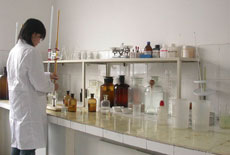
Section Three. Hazards Summarizing
Classification of Danger: Class 5.1 Oxidant
Invasion Route: Inhalation, Ingestion
Health Hazard: Calcium Hypochlorite is a penetrating conjunctival and respiratory irritant, which can cause tooth damages. Dermal exposure to it can induce medium or serious skin lesion.
Environmental Hazard: The chemical may cause damages to the environment, especially water bodies.
The Danger of Burning and Exploding: Non-combustibility
Section Four. First-aid Measures
Skin Contact: Remove contaminated clothing, flush the skin with soap and water, and get medical aid.
Eyes Contact: Hold the eyelids away from the eyeballs, flush with running water or physiological saline, and get medical aid.
Inhalation: Remove the victim from exposure and move to fresh air. Keep respiratory tract unimpeded. If breathing is difficult, give oxygen. If not breathing, give artificial respiration. Get medical aid.
Ingestion: Drink enough warm water, induce vomiting, and get medical aid.
Section Five. Fire-fighting Measures
Characteristics of Hazard: Strong oxidant. Contact with water or moist air may produce a burning explosion. To mix with alkaline substances can produce an explosion. Contact with organic substances may produce a risk of burning. Heat exposure, being treated with acids, or sunlight radiation can make the chemical decompose and release virulent Chlorine.
Hazardous Combustion Products: Chloride, Calcium Oxide
Fire-extinguishing Methods and Extinguishing Media: Extinguishing Media: Water, spray water, sandy clay.
Points for Attention in Fire-extinguishing: The Firemen should put on antigas masks and full fire-fighting suits.
Section Six. Accidental Release Measures
Emergency Handling: Isolate the contaminated area and restrict entry and exit. Suggest that the emergency handling workers equipp with self-contained breathing apparatus and dress themselve with general operation smocks. Don't directly contact the released chemical. Don't place the released chemical togther with reducers, organic substances tinders, or metallic powders. Release of Small Scale: Avoid raising dusts, and collect into dry, clean and covered containers with a clean spade. Release of Large Scale: Cover with plastic sheets or canvas, decrease distribution, and then collect and freight to waste disposal sites for disposal.
Section Seven. Handling and Storage
Notices of Operation: Operate in a gas-tighted condition, and strengthen ventilation. The operator should accepte specialized training and follow the exact operational regulations .
Notices of Storage: Store in shady, cool and ventilated storehouses. Keep away from kindling and heat. Prevent the sunlight from shining directly. Preserve apart from tinders or combustibles, acid, and etc. Avoid by all means mixed storage and mixed transport. Should not store in lager scale or for a long time. When transit, load and unload gently, and protect the package and container from being broken. Prohibit shaking, striking and attrition.
Section Eight. Exposure Controls/Personal Protection
Maximum Allowable Concentration: No Standard available.
Engineering Controls: Airproof the process of production. Strengthen ventilation. Provide with equipments for safety bath and eyes-washing.
Respiratory Protection: When possiblely exposure to its bug dust, one should wear head-type electric drive dust guards respirator.
Eyes Protection: Protection has been made in Respiratory Protection.
Body Protection: Put on the gas protection equipment of rubberized fabric.
Hands Protection: Wear neoprene gloves.
Other Protections: Do not smoke, take food and drink in workplaces. Have a bath and change clothes after work. Keep a good habit of personal hygiene.
Section Nine. Physical and Chemical Properties
Appearance and Physical State: White powder, with stong effluvium of chlorine. Its solution is a yellowish-green semitransparent liquid.
Melting Point ( ):100 (Decomposition) Relative-density Coefficient(Water=1):2.35
Boiling Point: Inanition Relative-density Coefficient(Air=1): 6.9
Saturated Vapor Pressure(kPa) : No data available Calorific Capacity(KJ/mol): Inanition
Flash Point ( ): Inanition Low Explosive Limit(%):Inanition
Solubility : (wt%water) 217g /L 27 Upper Explosive Limit: Inanition.
Dissolvability : Soluble in water. Main Uses: Be used asdisinfectant, germicide, bleaching agent and etc.
Section Ten. Stability and Reactivity
Stability: Stable
Incompatibility: Reducing agents, strong acids, ammonia, tinders or combustibles, organic substances and water.
Condition to Avoid: Air, humidity, and high temperature.
Hazardous Polymerization Indicator: No
Decomposition Products: Calcium Chloride, Oxygen, and Chlorine.
ection Eleven. Toxicological Information
Urgent Toxicity: LD 50 -850 mg/kg (Rats orally administrated)
LC 50 - No data available
Irritation: Inhalation: LC 50 3.5mg/L(Hour) Would not activate to death.Skin: rabbit>1000mg/kg Light totoxicity
Ingestion: LD 50 850mg/kg
ection Twelve. Ecological Information
Ecological Toxicity: High totoxicity for aquatics: LC 50 0.088 mg/L (96 Hours)
Biological Degradability: No data available.
Non-biological Degradability: No data available.
Section Thirteen. Disposal Considerations
Characteristic of Waste: Hazardous Waste
Waste Disposal Methods: Dispose of waste by safety landfill.
Section Fourteen. Transport Information
Serial Number of Dangerous Goods: 51043
UN Number: 1748
Labels for package: Oxidant (Corrosives)
Class of Package: II
Packaging Methods: Fully open steel cylinder; plastic tank
Section Fifteen. Regulatory Information
“Regulations on the Control over Safety of Dangerous Chemicals” ( Mandate of the State Council of the People's Republic of China. No. 344, Jan. 26, 2002) etc. have specified the safety production, application, storage, transport, load and unload of dangerous chemicals. “Classification and Labels of Dangerous Chemical Cubstances Commonly Used” (GB13690-92) classfies the chemical as Class 5.1-Oxidant.